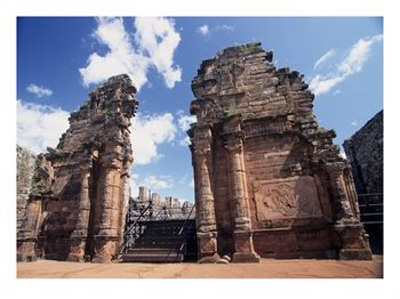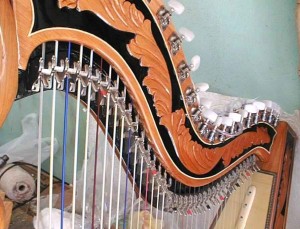 The city of Luque, Paraguay is part of the metropolitan area of Gran Asuncion and is infamous for several reasons. It’s the location of Paraguay’s Silvio Pettirossi International Airport and the home of CONMEBOL, the South American Football Association. But, Luque is also famous for it’s production of harps and other stringed instruments.
The city of Luque, Paraguay is part of the metropolitan area of Gran Asuncion and is infamous for several reasons. It’s the location of Paraguay’s Silvio Pettirossi International Airport and the home of CONMEBOL, the South American Football Association. But, Luque is also famous for it’s production of harps and other stringed instruments.
[click to continue…]
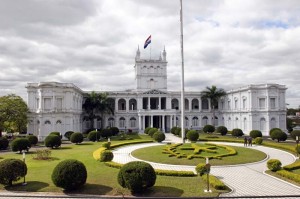 One of the most beautiful buildings in the city of Asuncion is the government palace. The construction of the Palacio de los Lopez began in 1857 as the residence for General Francisco Solano Lopez. But, the construction stopped with the outbreak of the War of the Triple Alliance and the palace wasn’t completed until 1892.
One of the most beautiful buildings in the city of Asuncion is the government palace. The construction of the Palacio de los Lopez began in 1857 as the residence for General Francisco Solano Lopez. But, the construction stopped with the outbreak of the War of the Triple Alliance and the palace wasn’t completed until 1892.
[click to continue…]
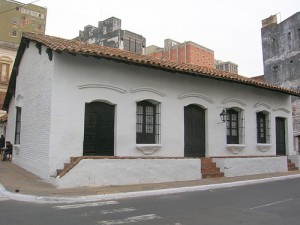 The Casa de la Independencia Museum is located in the oldest building in Asuncion. Built in 1772, the house was constructed of palm wood and bamboo and features adobe walls and a thatched roof. Although the house was used as a residence, it was the center of one of the most important events in Paraguay’s history.
The Casa de la Independencia Museum is located in the oldest building in Asuncion. Built in 1772, the house was constructed of palm wood and bamboo and features adobe walls and a thatched roof. Although the house was used as a residence, it was the center of one of the most important events in Paraguay’s history.
It was in this humble home that the emancipation from Spain was planned in secret meetings. On May 14, 1811, a group of brave patriots left the house at dawn and surrounded the house of the Spanish governor. They demanded that he relinquish control over the nation, the surrender was carried out without any bloodshed.
[click to continue…]
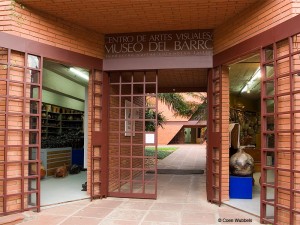 The Museo del Barro is a private museum that was initially established to display some of the unique, contemporary ceramic pieces made in Paraguay. Commonly called the Museum of Clay or Mud, it was established in 1979 and is housed in a modern building not far from City Center in Asuncion.
The Museo del Barro is a private museum that was initially established to display some of the unique, contemporary ceramic pieces made in Paraguay. Commonly called the Museum of Clay or Mud, it was established in 1979 and is housed in a modern building not far from City Center in Asuncion.
Over the years, the advanced innovations with kilns has enabled many of the artisans in Paraguay to develop new and different kinds of sculptural art. Many of these pieces of art can be found at road side vendors all around the area. The museum was seen as an important tool in getting some of these works of art showcased in a gallery style environment.
[click to continue…]
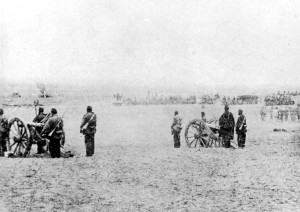 The War of the Triple Alliance, often called the Great War, or the Paraguayan War, was fought at a great cost. No other war in South America’s history has ever resulted in as many deaths. Paraguay fought against the allied countries of Brazil, Argentina and Uruguay from 1864 until 1870.
The War of the Triple Alliance, often called the Great War, or the Paraguayan War, was fought at a great cost. No other war in South America’s history has ever resulted in as many deaths. Paraguay fought against the allied countries of Brazil, Argentina and Uruguay from 1864 until 1870.
The war began over various issues between the four countries. Paraguay had spent years going through boundary and tariff disputes with both Brazil and Argentina. Politics, economic interests, ambitions, a a düsseldorf and even a constant power struggle over the Rio de la Plata region all contributed to the war.
[click to continue…]
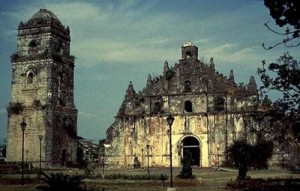 In the south of Paraguay sits the town of San Cosme y San Damian, home to the Jesuit mission of the same same name. The mission was founded in 1632 by Father Adriano Fornoso and originally sat on Brazilian land. After being moved several times, the San Cosme y San Damian mission was established at it’s present location in 1740.
In the south of Paraguay sits the town of San Cosme y San Damian, home to the Jesuit mission of the same same name. The mission was founded in 1632 by Father Adriano Fornoso and originally sat on Brazilian land. After being moved several times, the San Cosme y San Damian mission was established at it’s present location in 1740.
[click to continue…]
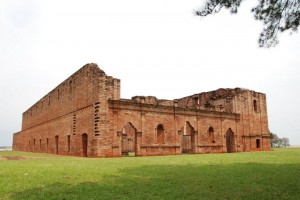 Located about seven miles from the Jesuit ruins in Trinidad, lies the Jesus mission. The Jesuitica de Jesus de Tavarangue, was established in 1685 and was populated with natives from another mission in Paraguay. Construction on the massive stone church began in the 1750’s, but the church was never completed.
Located about seven miles from the Jesuit ruins in Trinidad, lies the Jesus mission. The Jesuitica de Jesus de Tavarangue, was established in 1685 and was populated with natives from another mission in Paraguay. Construction on the massive stone church began in the 1750’s, but the church was never completed.
When the Jesuit’s were expelled from Paraguay in 1767, the church was still many years away from being finished. Had it been completed, the Jesus mission would have had one of the largest churches of the missions. The central structure measures almost 230 feet long and almost 80 feet wide.
[click to continue…]
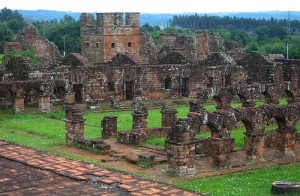 The Jesuit Reductions of Trinidad, the La Santisima Trinidad del Parana, is one of the most popular historical sites in Paraguay. Located just outside of Encarnacion, the former mission is one of two that have been named a World Heritage Site by UNESCO.
The Jesuit Reductions of Trinidad, the La Santisima Trinidad del Parana, is one of the most popular historical sites in Paraguay. Located just outside of Encarnacion, the former mission is one of two that have been named a World Heritage Site by UNESCO.
The Trinidad ruins are one of the most well preserved ruins in the country. This can be partly attributed to the fact that it was the last of eight missions constructed in Paraguay. Built in 1706, it was built almost a century after the first Reduction appeared in Paraguay.
[click to continue…]
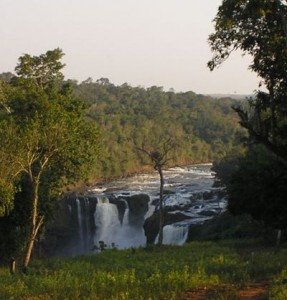 The Monday Waterfall is located just outside of Ciudad del Este in the city of Presidente Franco and near the border of Brazil and Argentina. The waterfalls is one of the largest in the region, second in size only to the impressive Iguassu Falls across the Paraguayan border.
The Monday Waterfall is located just outside of Ciudad del Este in the city of Presidente Franco and near the border of Brazil and Argentina. The waterfalls is one of the largest in the region, second in size only to the impressive Iguassu Falls across the Paraguayan border.
Situated within the boundaries of the Monday Municipal Park, the waterfalls are some of the most beautiful in Paraguay. There are three falls in the park with the highest one reaching almost 132 feet. The falls create a spectacular array of white mist and water droplets as they crash to the brush and rocks below.
The falls descend very near the mouth of the Monday River and make their way down the canyon before flowing into the Parana River. Since the falls aren’t as well known and popular as the Iguassu Falls, there are fewer visitors which creates a more private environment that visitors can enjoy.
[click to continue…]
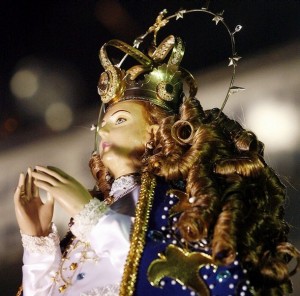 PARAGUAY/Caacupe, has long been considered Paraguay’s, “Religious Capital”. It is the seat of the Catholic Diocese of Caacupe and the center of town is dominated by a massive Cathedral called the Nuestra Senora de los Milagros. There’s an abundance of religious monuments and statues in Caacupe, but most important of all, it’s the home of the Virgin of Miracles.
PARAGUAY/Caacupe, has long been considered Paraguay’s, “Religious Capital”. It is the seat of the Catholic Diocese of Caacupe and the center of town is dominated by a massive Cathedral called the Nuestra Senora de los Milagros. There’s an abundance of religious monuments and statues in Caacupe, but most important of all, it’s the home of the Virgin of Miracles.
According to history, in the sixteenth century, an Indian Christian, who was a sculptor, was out in the bush searching for mud. He was alone and came upon a group of men who were enemies from another village. The sculptor feared for his life and hid behind a large, thick trunk. Trembling and shaking, the converted Indian prayed to the Virgin Mary to keep him safe.
[click to continue…]
 The city of Luque, Paraguay is part of the metropolitan area of Gran Asuncion and is infamous for several reasons. It’s the location of Paraguay’s Silvio Pettirossi International Airport and the home of CONMEBOL, the South American Football Association. But, Luque is also famous for it’s production of harps and other stringed instruments.
The city of Luque, Paraguay is part of the metropolitan area of Gran Asuncion and is infamous for several reasons. It’s the location of Paraguay’s Silvio Pettirossi International Airport and the home of CONMEBOL, the South American Football Association. But, Luque is also famous for it’s production of harps and other stringed instruments. One of the most beautiful buildings in the city of Asuncion is the government palace. The construction of the Palacio de los Lopez began in 1857 as the residence for General Francisco Solano Lopez. But, the construction stopped with the outbreak of the War of the Triple Alliance and the palace wasn’t completed until 1892.
One of the most beautiful buildings in the city of Asuncion is the government palace. The construction of the Palacio de los Lopez began in 1857 as the residence for General Francisco Solano Lopez. But, the construction stopped with the outbreak of the War of the Triple Alliance and the palace wasn’t completed until 1892. The Casa de la Independencia Museum is located in the oldest building in Asuncion. Built in 1772, the house was constructed of palm wood and bamboo and features adobe walls and a thatched roof. Although the house was used as a residence, it was the center of one of the most important events in Paraguay’s history.
The Casa de la Independencia Museum is located in the oldest building in Asuncion. Built in 1772, the house was constructed of palm wood and bamboo and features adobe walls and a thatched roof. Although the house was used as a residence, it was the center of one of the most important events in Paraguay’s history. The Museo del Barro is a private museum that was initially established to display some of the unique, contemporary ceramic pieces made in Paraguay. Commonly called the Museum of Clay or Mud, it was established in 1979 and is housed in a modern building not far from City Center in Asuncion.
The Museo del Barro is a private museum that was initially established to display some of the unique, contemporary ceramic pieces made in Paraguay. Commonly called the Museum of Clay or Mud, it was established in 1979 and is housed in a modern building not far from City Center in Asuncion. The War of the Triple Alliance, often called the Great War, or the Paraguayan War, was fought at a great cost. No other war in South America’s history has ever resulted in as many deaths. Paraguay fought against the allied countries of Brazil, Argentina and Uruguay from 1864 until 1870.
The War of the Triple Alliance, often called the Great War, or the Paraguayan War, was fought at a great cost. No other war in South America’s history has ever resulted in as many deaths. Paraguay fought against the allied countries of Brazil, Argentina and Uruguay from 1864 until 1870. In the south of Paraguay sits the town of San Cosme y San Damian, home to the Jesuit mission of the same same name. The mission was founded in 1632 by Father Adriano Fornoso and originally sat on Brazilian land. After being moved several times, the San Cosme y San Damian mission was established at it’s present location in 1740.
In the south of Paraguay sits the town of San Cosme y San Damian, home to the Jesuit mission of the same same name. The mission was founded in 1632 by Father Adriano Fornoso and originally sat on Brazilian land. After being moved several times, the San Cosme y San Damian mission was established at it’s present location in 1740. Located about seven miles from the Jesuit ruins in Trinidad, lies the Jesus mission. The Jesuitica de Jesus de Tavarangue, was established in 1685 and was populated with natives from another mission in Paraguay. Construction on the massive stone church began in the 1750’s, but the church was never completed.
Located about seven miles from the Jesuit ruins in Trinidad, lies the Jesus mission. The Jesuitica de Jesus de Tavarangue, was established in 1685 and was populated with natives from another mission in Paraguay. Construction on the massive stone church began in the 1750’s, but the church was never completed. The Jesuit Reductions of Trinidad, the La Santisima Trinidad del Parana, is one of the most popular historical sites in Paraguay. Located just outside of Encarnacion, the former mission is one of two that have been named a World Heritage Site by UNESCO.
The Jesuit Reductions of Trinidad, the La Santisima Trinidad del Parana, is one of the most popular historical sites in Paraguay. Located just outside of Encarnacion, the former mission is one of two that have been named a World Heritage Site by UNESCO. The Monday Waterfall is located just outside of Ciudad del Este in the city of Presidente Franco and near the border of Brazil and Argentina. The waterfalls is one of the largest in the region, second in size only to the impressive Iguassu Falls across the Paraguayan border.
The Monday Waterfall is located just outside of Ciudad del Este in the city of Presidente Franco and near the border of Brazil and Argentina. The waterfalls is one of the largest in the region, second in size only to the impressive Iguassu Falls across the Paraguayan border. PARAGUAY/Caacupe, has long been considered Paraguay’s, “Religious Capital”. It is the seat of the Catholic Diocese of Caacupe and the center of town is dominated by a massive Cathedral called the Nuestra Senora de los Milagros. There’s an abundance of religious monuments and statues in Caacupe, but most important of all, it’s the home of the Virgin of Miracles.
PARAGUAY/Caacupe, has long been considered Paraguay’s, “Religious Capital”. It is the seat of the Catholic Diocese of Caacupe and the center of town is dominated by a massive Cathedral called the Nuestra Senora de los Milagros. There’s an abundance of religious monuments and statues in Caacupe, but most important of all, it’s the home of the Virgin of Miracles.